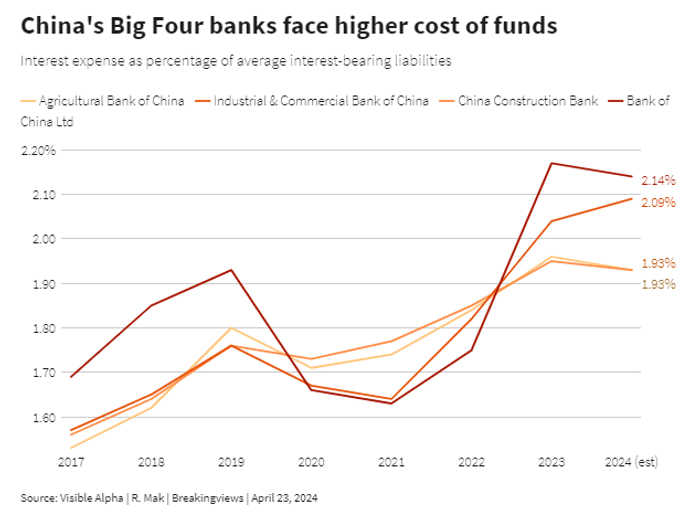Published 19:14 IST, May 7th 2024
China banks’ $900 bln buffer offers sham comfort
The FSB gave China's four largest state-owned lenders, which had combined assets of $21.5 trillion at the end of last year.
- Republic Business
- 3 min read
Feeling the LAC. China's largest lenders are fortifying their balance sheets to deal with a theoretical problem. The country's five biggest banks by assets must raise nearly $900 billion of special debt to comply with global rules for absorbing large-scale losses. The extra costs come at a delicate time.
The Financial Stability Board in 2015 adopted rules that force so-called global systemically important banks (G-SIBs) to hold a minimum amount of debt and equity that can be written off during a crisis. Rather than relying on taxpayer-funded government bailouts, the aim is for shareholders and junior creditors to absorb the losses.
The FSB gave China's four largest state-owned lenders, which had combined assets of $21.5 trillion at the end of last year, a decade to comply. By next January, Industrial and Commercial Bank of China, Bank of China, China Construction Bank and Agricultural Bank of China must have total loss-absorbing capacity (TLAC) equivalent to 16% of risk-weighted assets, rising to 18% by January 2028. Bank of Communications, which joined the G-SIB club in November, has an extra two years.
Fitch Ratings analysts expect the five Chinese banks to raise 6.2 trillion yuan ($859 billion) by January 2028. Most of that will probably be a new class of debt that can be written down or converted into equity after existing buffers have been wiped out. The largest of the group, ICBC, is preparing to sell TLAC bonds worth $5.5 billion to onshore investors, Bloomberg reported in April, citing people with knowledge of the matter.
For prospective buyers such as domestic asset and wealth managers or insurance companies, the risks are mostly hypothetical. The People’s Republic is the controlling shareholder of all five big banks, which play a vital role in driving industrial policy. Last year, the quintet extended net loans worth $1.5 trillion, per Visible Alpha, accounting for nearly half of new bank lending in the country. The chances that Beijing will allow them to get into serious trouble are extremely low.
Nevertheless, the bonds will add to banks’ funding costs. Analysts at CreditSights expect onshore TLAC notes to be slightly more expensive than senior debt. Over time, the financial institutions could redeem costlier junior notes. In the near term, though, the switch may put further pressure on the five banks’ average net interest margin, which fell to 1.55% last year from over 2% in 2019, Visible Alpha data show.
China’s central bank may further cut benchmark lending rates, which will eat into the lenders' earnings. Beijing is also prodding them to support the flagging property market, indebted local governments and newer sectors like green energy and electric vehicles. Other risks are piling up: U.S. officials have warned that Washington was ready to take action against Chinese firms supporting Russia's military, including targeting financial institutions with sanctions.
For China’s big banks, building a bigger safety buffer will provide little additional comfort.

Updated 19:14 IST, May 7th 2024